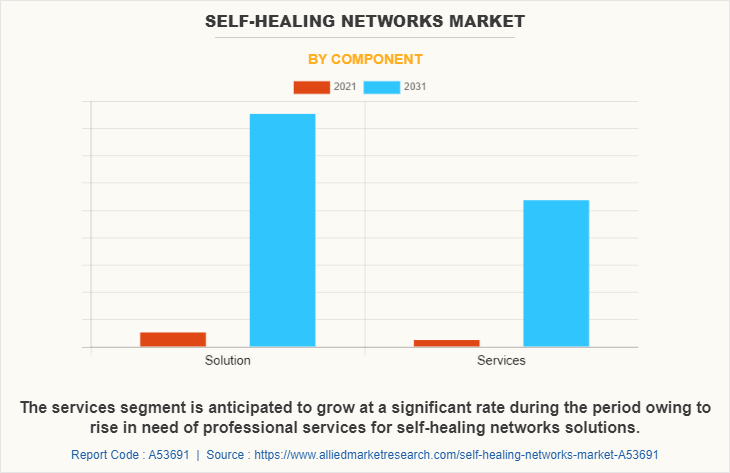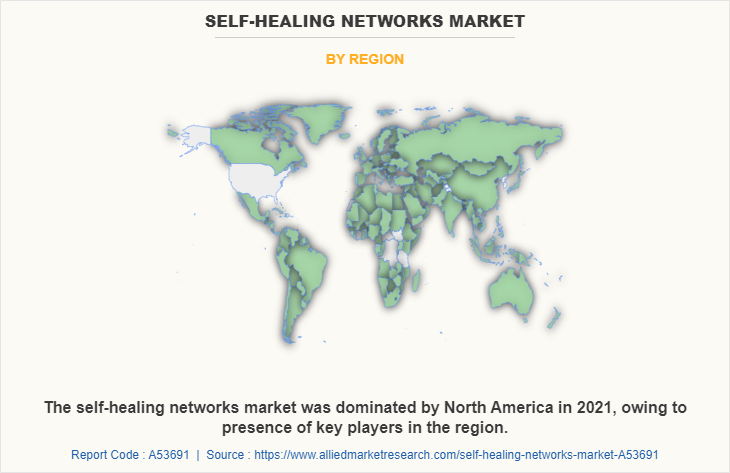Self-healing Networks Market Insights:
The global self-healing networks market size was valued at USD 729.6 million in 2021 and is projected to reach USD 13.9 billion by 2031, growing at a CAGR of 34.6% from 2022 to 2031.
Self-healing networks are designed to automatically detect and repair faults or errors within a network without the need for human intervention. This can help to reduce downtime, increase efficiency, and improve the overall performance of networked systems. In simpler terms, the self-healing networks comprise of tools and technologies that can automatically detect and fix network issues, reducing downtime and improving overall network performance.

The growing demand for high network availability is one of the key drivers of the self-healing networks market growth. This is attributed to the increasing reliance of businesses and consumers on efficient and scalable networks for smooth operations of the work without failure of the network system due to glitches in network systems. Thus, self-healing networks help to ensure high network availability by automatically detecting and fixing issues. Moreover, the increase in cyber threats is driving the self-healing networks market growth. As these attacks can cause significant damage to businesses, including financial losses, damage to reputation, and loss of customer trust. Therefore, these self-healing networks can help to mitigate the risk of cyber-attacks by automatically detecting and responding to security threats. Thus, by analyzing network traffic and identifying suspicious activity, self-healing networks can help to prevent cyber-attacks. Therefore, such factors provide lucrative opportunities for the growth of the market.
However, implementing self-healing network technology requires advanced equipment and software, which can be expensive to purchase and maintain. In addition, the implementation process can be complex and time-consuming, which can further increase the costs of deployment of self-healing networks. Therefore, for smaller companies or those with limited budgets, the high cost of implementation can be prohibitive, making it difficult for them to adopt this technology. Thus, this leads to retraining the growth of the market. On the contrary, the increase in network efficiency creates an opportunity for the self-healing network market players. This is because a self-healing network is designed to automatically detect and recover from network faults or failures, without requiring manual intervention.
Moreover, with the increase in network efficiency, self-healing network solutions can offer significant benefits to organizations in terms of reducing operational costs, improving customer satisfaction, and enhancing overall network performance. Thus, such factors are likely to boost the self-healing networks market share during the forecast period.
Segment Review:
The self-healing networks market is segmented based on component, network type, enterprise size, deployment mode, application, industry vertical, and region. Based on component, it is classified into solution and services. By network type, it is divided into physical, virtual, and hybrid. By enterprise size, it is classified into large enterprises and small & medium enterprises. By deployment mode, it is divided into on-premises and cloud. By application, it is classified into network provisioning, network bandwidth monitoring, network traffic management, and network access control. By industry vertical, it is divided into IT and telecom, BFSI, media and entertainment, healthcare and life sciences, retail & consumer goods, education, and others. By region, it is analyzed across North America, Europe, Asia-Pacific, and LAMEA.

By component, the solution segment accounted for the highest growth in 2021. This is because, the adoption of software-defined networking (SDN) is driving the development of more advanced self-healing network solutions, as it allows for greater automation and flexibility in network management. Thus, such trends in the solution segment of self-healing networks are driving innovation and growth in the market, and are expected to continue to develop the market in the upcoming years. However, the services segment is predicted to be the fastest growing during the self-healing networks market forecast. This is attributed to the fact that; the services segment is essential for helping customers to maximize the benefits of self-healing networking technologies. Thus, by providing expert guidance and ongoing support, service providers can help customers achieve greater network reliability, availability, and performance while reducing operational costs and minimizing downtime. Therefore, these factors are expected to drive the growth of the segment in this market.

By region, North America accounted for the highest growth in 2021. This is due to increasing demand for uninterrupted network connectivity, particularly in critical industries such as healthcare, finance, and transportation. Furthermore, the need for reliable and secure communication networks in the aftermath of natural disasters and other emergencies is also driving the growth of the self-healing networks market. However, Asia-Pacific is projected to be the fastest-growing region during the forecast period. This is due to the high rate of adoption of new technologies among Asia-Pacific countries and the increase in adoption of cloud-based services, the rise of the Internet of Things (IoT), and the need for high-speed, low-latency networks to support emerging technologies such as 5G, leads to the growth of the market in this region.
Top Impacting Factors:
Growing Demand for High Network Availability
The growing demand for high network availability is one of the key drivers of the self-healing networks market. Furthermore, with the increase in reliance on digital technologies, businesses and consumers alike require high network availability to ensure that their operations can continue without disruption. Moreover, it helps to ensure high network availability by automatically detecting and fixing issues. Thus, this reduces the need for human intervention, which can help to reduce downtime and increase network reliability.
In addition, self-healing networks can help to reduce the cost of network maintenance and management. By automating the process of detecting and fixing issues, businesses can reduce the need for manual intervention and reduce the time and resources required to manage their networks. The growing demand for high network availability is expected to continue to drive the growth of the self-healing networks industry.
Adoption of Cloud Computing
The adoption of cloud computing is another important driver of the self-healing networks market. Cloud computing has become increasingly popular due to its scalability, flexibility, and cost-effectiveness. However, self-healing networks can help to ensure the availability and reliability of the network infrastructure that supports cloud computing. In addition, self-healing networks help to improve the performance of cloud-based services. By quickly identifying and fixing network issues, self-healing networks can help to minimize latency and ensure fast and reliable data transfer. Overall, the adoption of cloud computing is expected to continue to drive the growth of the self-healing networks market.
Increase in Cyber Threats
The increase in cyber threats is driving the self-healing networks market. As cybersecurity has become a major concern for businesses and governments due to the increasing frequency and complexity of cyber-attacks. Thus, these attacks can cause significant damage to businesses, including financial losses, damage to reputation, and loss of customer trust. Moreover, these self-healing networks can help to mitigate the risk of cyber-attacks by automatically detecting and responding to security threats. Therefore, by analyzing network traffic and identifying suspicious activity, self-healing networks can help to prevent cyber-attacks.
In addition, self-healing networks can help businesses to comply with regulatory requirements for cybersecurity. As many industries are subject to strict regulations regarding data protection and cybersecurity, and failure to comply can result in significant fines and legal penalties. Moreover, the increase in cyber threats is expected to continue to drive the growth of the self-healing networks market. As businesses become more aware of the risks associated with cyber-attacks, the demand for reliable and self-healing network infrastructure is projected to increase in the upcoming years.
Lack of Standardization
The lack of standardization can make it difficult for companies to compare products and choose the best solution for their needs. Furthermore, without a clear set of standards, it can be challenging to evaluate products objectively and determine which one will provide the most significant benefits. In addition, the lack of standardization is also predicted to hinder innovation in the industry. Furthermore, due to a lack of clarity on standards, vendors may be hesitant to invest in developing new features and capabilities for their products, as they may not be widely adopted by the market. However, efforts are made to establish standards for self-healing networks. Thus, lack of standardization in the industry is expected to be the major factor restraining the growth of the self-healing networks market.
High Implementation Cost
Implementing self-healing network technology requires advanced equipment and software, which can be expensive to purchase and maintain. In addition, the implementation process can be complex and time-consuming, which can further increase the costs of deployment of self-healing technologies in networks. Furthermore, for smaller companies or those with limited budgets, the high cost of implementation can be prohibitive, making it difficult for them to adopt this technology. Moreover, the high costs associated with self-healing networks are also expected to lead to slower adoption rates by companies in developing countries or regions with limited resources. Thus, these factors are predicted to hamper the growth of the market.
Increase in Network Efficiency
The increase in network efficiency creates an opportunity for the self-healing network market. This is because a self-healing network is designed to automatically detect and recover from network faults or failures, without requiring manual intervention. Furthermore, with an increase in network efficiency, the overall performance of the network can be improved, which can lead to reduced downtime and increased availability of networks.
However, as the complexity of networks increases, so does the likelihood of network failures or outages. In such scenarios, self-healing networks help to quickly identify and resolve issues, which can further improve network efficiency. Therefore, with the increase in demand for high-performance and reliable networks, self-healing network solutions can offer significant benefits to organizations in terms of reducing operational costs, improving customer satisfaction, and enhancing overall network performance.
Market Landscape and Trends:
The self-healing networks industry is experiencing a number of trends and opportunities as businesses seek to improve their network performance and reduce downtime. One of the key trends in the market is the increase in the adoption of artificial intelligence ai and machine learning ml technologies to optimize network operations and enable self-healing capabilities. This technology allows networks to automatically detect and respond to potential issues, minimizing the need for human intervention. Another trend is the rise of cloud-based solutions, which offer scalability, flexibility, and cost savings compared to traditional on-premises solutions. As more businesses shift their operations to the cloud, the demand for self-healing networks is expected to rise in the upcoming years.
The growing number of connected devices, particularly with the rise of the Internet of Things (IoT), is also driving the demand for self-healing networks. With the increase in complexity and diversity of devices on networks, self-healing solutions can help businesses manage their networks more effectively. Overall, the self-healing networks market offers significant opportunities for businesses looking to improve their network performance, reduce downtime, and stay ahead of the competition.
Key Benefits for Stakeholders:
- This report provides a quantitative analysis of the market segments, current trends, estimations, and dynamics of the self-healing networks market analysis from 2022 to 2031 to identify the prevailing self-healing networks market opportunities.
- The market research is offered along with information related to key drivers, restraints, and opportunities.
- Porter's five forces analysis highlights the potency of buyers and suppliers to enable stakeholders to make profit-oriented business decisions and strengthen their supplier-buyer network.
- An in-depth analysis of the self-healing networks market segmentation assists to determine the prevailing market opportunities.
- Major countries in each region are mapped according to their revenue contribution to the global market.
- Market player positioning facilitates benchmarking and provides a clear understanding of the present position of the market players.
- The report includes an analysis of the regional as well as global self-healing networks market trends, key players, market segments, application areas, and market growth strategies.
Self-healing Networks Market Report Highlights
| Aspects | Details |
| Market Size By 2031 | USD 13.9 billion |
| Growth Rate | CAGR of 34.6% |
| Forecast period | 2021 - 2031 |
| Report Pages | 245 |
| By Industry Vertical |
|
| By Component |
|
| By Network Type |
|
| By Enterprise Size |
|
| By Deployment Mode |
|
| By Application |
|
| By Region |
|
| Key Market Players | VMware, Inc., Ivanti, Nokia, Cisco Systems, Inc., Appnomic, Fortra LLC, Ericsson, IBM Corporation, Versa Networks, Inc., CommScope |
Analyst Review
Self-healing networks refer to the networks that have the ability to detect and automatically recover from failures without the need for manual intervention. Thus, these networks are designed to maintain continuous service even in the event of disruptions or outages caused by hardware failures, software glitches, cyberattacks, natural disasters, or other unforeseen circumstances.
Furthermore, market players are adopting strategies like product launch for enhancing their services in the market and improving customer satisfaction. For instance, in December 2022, Verizon launches self-healing network to improve customer experience. Verizon has unveiled a new self-healing network that uses automation and machine learning to detect and resolve network issues in real-time. This network is designed to provide faster response times and minimize downtime for customers, particularly in high-traffic areas such as stadiums and airports. Therefore, such strategy helps to grow the self-healing networks market in upcoming years.
Moreover, some of the key players profiled in the report include are Appnomic, Cisco Systems, Inc., CommScope, Ericsson, Fortra LLC, IBM, Ivanti, Nokia, Versa Networks, Inc., and VMware, Inc. These players have adopted various strategies to increase their market penetration and strengthen their position in the industry.
The Self-healing Networks Market valued for $729.64 million in 2021 and is estimated to reach $13,904.30 million by 2031, exhibiting a CAGR of 34.6% from 2022 to 2031.
The growing demand for high network availability, adoption of cloud computing, and the increasing cyber threats are major factors projected to drive the market growth.
North America is the largest regional market for Self-healing Networks Market.
The key growth strategies include product portfolio expansion, acquisition, partnership, merger, and collaboration.
The report analyzes the profiles of key players operating in the self-healing networks market such as Appnomic, Cisco Systems, Inc., CommScope, Ericsson, Fortra LLC, IBM, Ivanti, Nokia, Versa Networks, Inc., and VMware, Inc.
Loading Table Of Content...
Loading Research Methodology...



